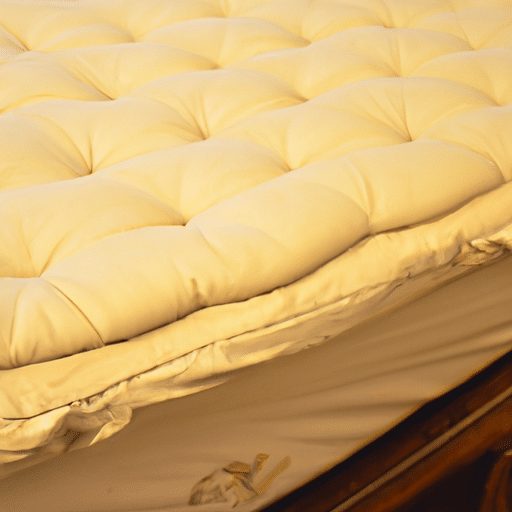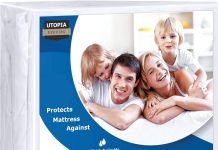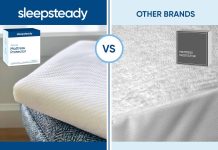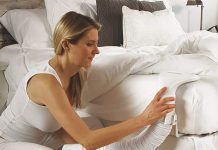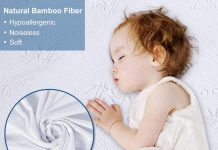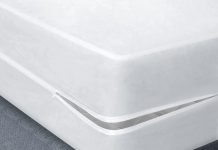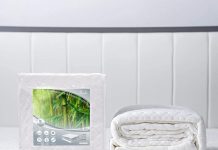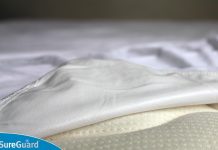Using a mattress protector is a smart and practical decision that can prolong the life of your mattress and provide added comfort while you sleep. But when is the right time to start using one? Whether you’ve just purchased a brand new mattress or you’re looking to protect your current one, understanding the circumstances in which a mattress protector is beneficial is key. In this article, we will discuss the various situations where using a mattress protector can greatly benefit you and your mattress, ensuring a restful and hygienic sleeping environment.
Review contents
Benefits of using a mattress protector
Using a mattress protector offers numerous benefits that can help enhance not only the comfort and cleanliness of your bed but also its overall longevity. Let’s explore some of the key advantages of using a mattress protector.
Protecting against spills and stains
One of the primary benefits of using a mattress protector is its ability to safeguard your mattress against spills, stains, and accidents. Whether it’s a spilled drink, a pet accident, or a late-night snack mishap, a mattress protector acts as a barrier, preventing liquid and other substances from seeping into the mattress layers. This protection is especially helpful in maintaining the cleanliness and freshness of your mattress, ensuring that it remains hygienic and odor-free.
Preventing dust mites and allergens
Another significant benefit of using a mattress protector is its ability to create a shield against dust mites and allergens. Dust mites, which are microscopic creatures that thrive in mattresses, can trigger allergies and respiratory problems. A mattress protector acts as a barrier, preventing these tiny pests from penetrating the mattress and establishing a breeding ground. Additionally, a mattress protector can also trap allergens such as pet dander, pollen, and dust particles, reducing your exposure to potential allergens and creating a healthier sleep environment.
Increasing mattress lifespan
Investing in a high-quality mattress is a significant financial commitment, and it’s only natural to want to protect that investment. A mattress protector can help prolong the lifespan of your mattress by safeguarding it against wear and tear. The protector acts as a physical barrier, shielding the mattress from bodily oils, sweat, and dead skin cells that can accumulate over time. By preventing these substances from seeping into the mattress, a protector can help maintain the mattress’s integrity and extend its overall lifespan.
Types of mattress protectors
When it comes to mattress protectors, there are several different types available, each with its distinctive features and benefits. Understanding these variations can help you choose the right protector for your specific needs. Here are three common types of mattress protectors:
Waterproof protectors
As the name suggests, waterproof mattress protectors offer ultimate protection against liquid spills and stains. These protectors are typically made with a breathable, waterproof membrane that acts as a barrier, preventing any liquids from seeping through to the mattress. Waterproof protectors are particularly useful for households with young children, pets, or individuals prone to accidents.
Allergen-proof protectors
If you suffer from allergies or asthma, an allergen-proof mattress protector can be a game-changer. These protectors are designed to repel allergens such as dust mites, pet dander, and pollen, keeping them from infiltrating your mattress and triggering allergenic reactions. Allergen-proof protectors are often made with tightly woven fabrics or specialized materials that create a barrier against allergens, providing a safe and clean sleep environment.
Quilted protectors
For those seeking an extra layer of comfort, quilted mattress protectors are an excellent option. These protectors feature a layer of padding or quilting on top, adding a plush and cushioned feel to your sleeping surface. Quilted protectors not only offer protection against spills and stains but also enhance the overall comfort and softness of your mattress. They are an ideal choice for individuals looking to add an additional layer of coziness to their sleeping experience.
Protection for different mattress types
Different types of mattresses require different levels of protection and care. Whether you have a foam mattress, innerspring mattress, or a hybrid mattress, using a mattress protector can help safeguard your investment. Here’s how mattress protectors cater to various mattress types:
Foam mattresses
Foam mattresses, known for their contouring and pressure-relieving properties, can benefit greatly from the use of a mattress protector. Foam is highly absorbent, making it more susceptible to spills and stains. A mattress protector acts as a barrier, preventing any liquids from seeping into the foam layers and potentially compromising the mattress’s structural integrity. Additionally, a protector can also help regulate temperature by wicking away moisture, ensuring a cooler and more comfortable sleep surface.
Innerspring mattresses
Innerspring mattresses feature a coil support system, providing a bouncy and responsive feel. While these mattresses can be resilient and durable, they are not immune to spills or allergens. A mattress protector can protect the innerspring unit from damage caused by liquid spills or stains, helping to maintain the mattress’s structural integrity. Additionally, a protector can also help minimize noise, as the waterproof or quilted materials provide a buffer between the sleeper and the coils, reducing any potential squeaking sounds.
Hybrid mattresses
Hybrid mattresses combine the support of innerspring coils with the pressure relief of foam or latex layers. These mattresses often come with a significant investment, and protecting them is essential for maximizing their lifespan. A mattress protector acts as a barrier, safeguarding the hybrid mattress from spills, stains, and allergens. With the right protector, you can prolong the life of your hybrid mattress, ensuring its durability and performance for years to come.
Ideal scenarios for using a mattress protector
While using a mattress protector is beneficial for any bed, there are specific situations where it becomes even more essential. Here are a few ideal scenarios for utilizing a mattress protector:
For young children or bedwetters
If you have young children or individuals who are prone to bedwetting, a mattress protector is a must-have accessory. Accidents happen, but that doesn’t mean your mattress has to suffer. Using a waterproof protector provides an effective barrier against spills and stains caused by bedwetting incidents, ensuring that your mattress remains free from damage.
For those with allergies or asthma
Individuals with allergies or asthma can greatly benefit from the protection offered by a mattress protector. Allergens such as dust mites, pet dander, and pollen can trigger significant discomfort for allergy sufferers. By using an allergen-proof mattress protector, you can create a barrier that prevents these allergens from accumulating in the mattress, allowing for a cleaner and healthier sleep environment.
For individuals who eat or drink in bed
We’ve all had those moments when we enjoy a late-night snack or a morning coffee in bed. However, spills and accidents are not uncommon in these cases. By using a mattress protector, you can enjoy your meals or beverages in bed without worrying about staining or damaging your mattress. A waterproof or stain-resistant protector can provide the necessary protection against spills, allowing you to indulge in bed-bound leisure without any guilt or stress.
Choosing the right mattress protector
Now that you understand the benefits and types of mattress protectors, it’s important to consider certain factors when selecting the right protector for your needs. Here are some key considerations:
Considerations for material
Mattress protectors come in a variety of materials, including cotton, polyester, vinyl, and specialized fabrics. Consider your preferences for breathability, comfort, and durability when choosing the material. Look for protectors that are hypoallergenic and free of harmful chemicals, ensuring a safe and healthy sleep environment.
Ease of cleaning and maintenance
Regular cleaning and maintenance of your mattress protector are crucial to ensure its effectiveness and longevity. Look for protectors that are machine washable or easy to clean, allowing for hassle-free maintenance. Additionally, consider the drying time and whether the protector can withstand multiple washes without losing its protective qualities.
Hypoallergenic features
If you or your loved ones suffer from allergies, selecting a hypoallergenic mattress protector is essential. These protectors are designed to minimize allergen exposure, making them ideal for individuals with sensitivities. Look for protectors specifically labeled as hypoallergenic or allergy-proof, and ensure that they have been tested and certified to meet relevant standards.
Tips for using a mattress protector effectively
Once you have chosen the right mattress protector, it’s important to utilize it effectively to maximize its benefits. Here are some helpful tips to ensure the proper use of your mattress protector:
Regularly washing and maintaining the protector
To keep your mattress protector in optimal condition, it’s crucial to follow the manufacturer’s instructions for washing and maintenance. Regularly wash the protector according to the recommended frequency, using mild detergent and warm water. Avoid using harsh chemicals or bleach, as they can degrade the protector’s materials.
Ensuring proper fit and installation
Proper fit and installation of the mattress protector are essential for its effectiveness. Ensure that the protector covers the entire surface of the mattress, including the sides. A snug fit will prevent the protector from slipping or bunching up, ensuring consistent protection. Follow the manufacturer’s guidelines for installation to ensure a secure and proper fit.
Replacing the protector when necessary
While mattress protectors are designed to be durable, they are not meant to last forever. Over time, wear and tear may lessen their protective capabilities. Monitor the condition of your mattress protector regularly and replace it when you notice signs of damage or decreased effectiveness. By replacing your protector when necessary, you can continue to enjoy the benefits of a clean and protected mattress.
Alternatives to mattress protectors
While mattress protectors are highly recommended for maintaining the cleanliness and longevity of your mattress, there are alternatives available that can provide similar benefits. Here are a few alternatives worth considering:
Mattress pads
Mattress pads are thick layers of cushioning that sit on top of your mattress. While they do not offer the same level of protection as mattress protectors, they can provide an extra layer of comfort and plushness to your bed. Mattress pads are typically used to add softness or modify the feel of a mattress, rather than for protection against spills or stains.
Mattress toppers
Similar to mattress pads, mattress toppers are designed to enhance the comfort of your bed. Toppers are usually thicker than pads and can offer additional support or pressure relief. However, like pads, they are not specifically designed for protecting your mattress against spills, stains, or allergens.
Waterproof bedding
If you’re primarily concerned about protecting your mattress from liquid spills or stains, using waterproof bedding can be an alternative option. Waterproof sheets or mattress encasements are designed to offer a protective layer against liquids, ensuring that your mattress remains unaffected. However, they may not provide the same level of breathability or comfort as dedicated mattress protectors.
Common misconceptions about mattress protectors
There are a few misconceptions surrounding mattress protectors that may deter individuals from using them. Let’s debunk some of these myths:
They make the mattress uncomfortable
Some people worry that adding a mattress protector will make their bed feel less comfortable or alter the mattress’s feel. However, high-quality mattress protectors are designed to be thin and breathable, allowing you to enjoy the full comfort and support of your mattress while providing protection. Look for protectors that explicitly mention maintaining the original feel of the mattress.
They are unnecessary for high-quality mattresses
Even if you have invested in a high-quality mattress, using a mattress protector is still essential. While these mattresses often have built-in features for breathability, comfort, or durability, they may still be susceptible to spills, stains, or allergens. Protecting your mattress with a quality protector adds an extra layer of defense, ensuring its longevity and maintaining its pristine condition.
They are difficult to clean
Cleaning a mattress protector is often as simple as tossing it in the washing machine. High-quality protectors are designed to withstand regular washing without losing their protective properties. By following the manufacturer’s instructions, you can easily clean and maintain your mattress protector, keeping it fresh and in top condition.
Conclusion
Using a mattress protector offers numerous benefits that can enhance the comfort, cleanliness, and lifespan of your mattress. By protecting against spills and stains, preventing dust mites and allergens, and increasing mattress lifespan, a mattress protector becomes an essential accessory for any bed. From waterproof protectors to allergen-proof varieties, there are different types available to cater to various needs and preferences. Whether you have a foam mattress, innerspring mattress, or a hybrid mattress, using a protector safeguards your investment and ensures its durability. Ideal scenarios for using a mattress protector include households with young children, individuals with allergies or asthma, and those who consume food or drink in bed. When choosing a mattress protector, consider factors such as material, ease of cleaning, and hypoallergenic features. Following tips for effective use, such as regular cleaning and replacement, will help maintain the protector’s functionality. While alternatives like mattress pads, toppers, or waterproof bedding are an option, they offer different benefits and may not provide the same level of protection as dedicated mattress protectors. Dispelling common misconceptions, such as discomfort or unnecessary protection for high-quality mattresses, emphasizes the importance of using a mattress protector. So take the necessary steps to protect your mattress and enjoy a clean, comfortable, and long-lasting sleep environment.

